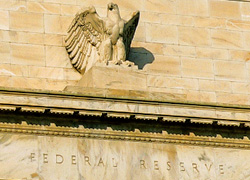(Reuters) – The dollar held near two-week highs on Wednesday, as concerns about Sino-U.S. trade tensions propped up safe haven currencies and as investors awaited cues from the U.S. Federal Reserve on the path of future interest rate increases.
The dollar has been under pressure in recent weeks on signs the Fed might slow the pace of future rate increases due to slowing global growth, peak corporate earnings and escalating trade tensions.
Attention has now turned to a speech by Fed Chairman Jerome Powell later on Wednesday and the minutes from the Fed’s Nov. 7-8 meeting on Thursday. Markets hope to gain fresh insights into the Fed’s thinking on the speed and number of rate hikes in the current cycle.
“We don’t think Powell will diverge too much from the Fed’s data dependent approach. Our base case remains for the Fed to raise rates 4 times in 2019,” said Terence Wu, currency strategist at OCBC Bank.
The U.S. central bank is widely expected to raise rates by 25 basis points next month.
In an interview to the Washington Post on Tuesday, U.S. President Donald Trump said he is unhappy with the Fed’s policy stance and Powell, whom he picked last year to lead the bank.
Trump has repeatedly criticized the Fed and Powell on the U.S. central bank’s monetary policy stance, saying rising U.S. rates were harming the economy.
But analysts think it is unlikely that political interference can alter the Fed’s approach to formulating monetary policy.
“The Fed relishes its independence and their approach is very mathematical and systematic. Under no circumstances do we expect the U.S. central bank to be pressured by Trump,” said Stephen Innes, head of trading, APAC at Oanda.
In comments made on Tuesday, Federal Reserve Vice Chair Richard Clarida backed further rate hikes though he said the tightening path would be data dependent. He said monitoring of economic data has become even more critical as the Fed edged ever closer to a neutral stance.
“Clarida went back to the usual script and his comments did not contain the dovish overtone as some had expected,” said Wu.
The dollar index (DXY), a gauge of its value versus six major peers, traded at 97.38 having risen for three sessions in a row. It is just below this year’s high of 97.69.
Dollar strength also reflected risks around the upcoming G20 summit in Buenos Aires between Nov. 30-Dec. 1 where Trump and his Chinese counterpart, Xi Jinping, are scheduled to discuss contentious trade matters.
Trump’s comments this week that it was “highly unlikely” he would accept China’s request to hold off a planned increase in tariffs drove investors to safe-haven currencies such as the dollar and the yen.
The yen hit a two-week low of 113.85 on Wednesday.
“Interest rate differentials between U.S. and Japan are likely to support dollar/yen going ahead,” added Wu.
The euro (EUR=) gained 0.07 percent versus the dollar to $1.1295. The single currency has lost 1.5 percent of its value in recent sessions due to signs of weakening eurozone economic momentum and ongoing tensions between the European Union and Italy over Rome’s free spending budget.
Elsewhere, sterling was a touch lower at $1.2742. The pound is likely to remain under pressure as traders bet that British Prime Minister Theresa May would fail to get the nod for her Brexit agreement in a fractious parliament.
The Australian dollar, often considered a gauge for global risk appetite, gained 0.15 percent to $0.7231 as Asian equities pushed higher.
However, analysts expect the Aussie dollar to remain vulnerable to further declines amid sharp losses in the price of iron ore, a key export earner for the country, and as U.S.-Sino trade tensions showed no signs of abating.
ECONOMIC CALENDAR EVENTS FOR NOVEMBER 28th
NZD RBNZ Governor Orr Speech
NZD RBNZ Governor Orr Speech
GBP Bank Stress Test Results
GBP Financial Stability Report
CHF ZEW Survey – Expectations (Nov)
USD Gross Domestic Product Price Index (Q3)
USD Gross Domestic Product Annualized (Q3)
USD Core Personal Consumption Expenditures (QoQ) (Q3)
USD Personal Consumption Expenditures Prices (QoQ) (Q3)
USD New Home Sales (MoM) (Oct)
GBP BOE’s Governor Carney speech
USD Fed’s Powell Speech


